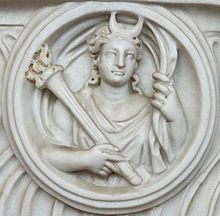
Back Selene Afrikaans سيليني Arabic Selene AST Selena Azerbaijani Selene BAR Selene BCL Селена Byelorussian Сэлена BE-X-OLD Селена Bulgarian সেলেনে Bengali/Bangla
| Selene | |
|---|---|
Personification of the Moon | |
 Detail of Selene from a Roman sarcophagus | |
| Other names | Mene (Μήνη) |
| Greek | Σελήνη |
| Abode | Sky |
| Planet | Moon[1] |
| Animals | Horse, bull, mule |
| Symbol | Crescent, chariot, torch, billowing cloak, bull, moon |
| Day | Monday (hēméra Selḗnēs) |
| Personal information | |
| Parents | Hyperion and Theia |
| Siblings | Helios and Eos |
| Consort | Endymion |
| Children | Fifty daughters, Narcissus, Pandia, Ersa, Horae, Musaeus |
| Equivalents | |
| Roman equivalent | Luna |
| Phrygian equivalent | Men |
In ancient Greek mythology and religion, Selene (/sɪˈliːniː/; Greek: Σελήνη pronounced [selɛ̌ːnɛː] seh-LEH-neh, meaning "Moon")[2] is the goddess and personification of the Moon. Also known as Mene, she is traditionally the daughter of the Titans Hyperion and Theia, and sister of the sun god Helios and the dawn goddess Eos. She drives her moon chariot across the heavens. Several lovers are attributed to her in various myths, including Zeus, Pan, and the mortal Endymion. In post-classical times, Selene was often identified with Artemis, much as her brother, Helios, was identified with Apollo.[3] Selene and Artemis were also associated with Hecate and all three were regarded as moon and lunar goddesses, but only Selene was regarded as the personification of the Moon itself.
Her equivalent in Roman religion and mythology is the goddess Luna.[4]
| Part of a series on |
| Ancient Greek religion |
|---|
 |
- ^ Evans, James (1998). The History and Practice of Ancient Astronomy. Oxford University Press. pp. 296–7. ISBN 978-0-19-509539-5. Retrieved 2008-02-04.
- ^ A Greek–English Lexicon s.v. σελήνη.
- ^ Hard, p. 46; Oxford Classical Dictionary, s.v. Selene; Morford, pp. 64, 219–220; Smith, s.v. Selene.
- ^ Smith, s.v. Selene; Kerényi, pp. 196–197; Oxford Classical Dictionary, s.v. Selene; Hard, p. 46; Morford, pp. 64, 219–221.
© MMXXIII Rich X Search. We shall prevail. All rights reserved. Rich X Search